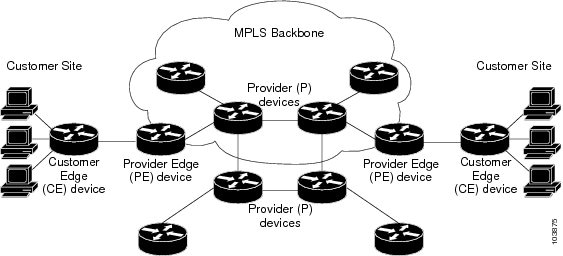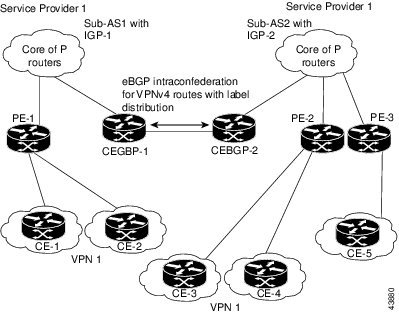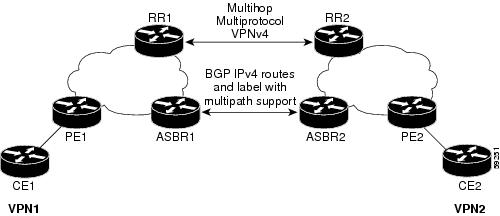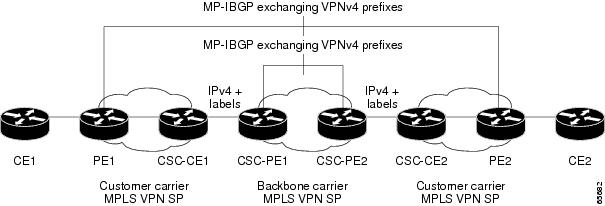This section describes how to configure the EVPN IGMP L3 Synchronization feature.
Verification
Verify that you have configured EVPN IGMP L3 synchronization successfully.
/* Verify EVPN ethernet-segment peers */
Router# show evpn ethernet-segment
Ethernet Segment Id Interface Nexthops
------------------------ ---------------------------------- --------------------
0000.0100.ac00.0001.0a00 BE1 10.0.0.1
172.16.0.1
--------------------------------------------------------------------------------
/* Verify multihome interface is enabled in IGMP */
Router# show igmp vrf vpn101 interface bundle-ether 1.10
Bundle-Ether1.10 is up, line protocol is up
Internet address is 192.168.0.1 255.255.0.0
IGMP_AFD is enabled on interface
Multihoming is enabled on interface [Stale : False]. -> multihome must be enabled
Current IGMP version is 3
/* Verify bucket IDS in control plane and hardware */
Router# show mrib evpn bucket-db
EVPN Bucket Database
--------------------
IFName IFHandle BucketID State Uptime Delete In Progress
Bundle-Ether1 0x20008e0 0 Forward 3d17h N
Bundle-Ether1 0x20008e0 1 Blocked 3d17h N
Bundle-Ether1 0x20008e0 2 Forward 3d17h N
Bundle-Ether1 0x20008e0 3 Blocked 3d17h N
Bundle-Ether1 0x20008e0 4 Forward 3d17h N
Bundle-Ether1 0x20008e0 5 Blocked 3d17h N
Bundle-Ether1 0x20008e0 6 Forward 3d17h N
Bundle-Ether1 0x20008e0 7 Blocked 3d17h N
Bundle-Ether1 0x20008e0 8 Forward 3d17h N
Bundle-Ether1 0x20008e0 9 Blocked 3d17h N
Bundle-Ether1 0x20008e0 10 Forward 3d17h N
Bundle-Ether1 0x20008e0 11 Blocked 3d17h N
Router# show mfib platform evpn bucket location 0/1/CPU0
LC Type: A9K-4X100GE-TR
------------------------------------------------------
ESI Interface Handle Bucket ID State Stale
------------------------------------------------------
Bundle-Ether1 0x4000620 0 DF F
Bundle-Ether1 0x4000620 1 NDF F
Bundle-Ether1 0x4000620 2 DF F
Bundle-Ether1 0x4000620 3 NDF F
Bundle-Ether1 0x4000620 4 DF F
Bundle-Ether1 0x4000620 5 NDF F
Bundle-Ether1 0x4000620 6 DF F
Bundle-Ether1 0x4000620 7 NDF F
Bundle-Ether1 0x4000620 8 DF F
Bundle-Ether1 0x4000620 9 NDF F
Bundle-Ether1 0x4000620 10 DF F
Bundle-Ether1 0x4000620 11 NDF F
------------------------------------------------------
If duplicate traffic is seen or one of the PEs is dropping traffic even though the routes are present, it could be that bucket ID states are incorrect in hardware or control plane.
Verify IGMP report in IGMP, EVPN, and BGP.
Router:PE1# show igmp vrf vpn101 groups 209.165.201.1 detail
Interface: Bundle-Ether1.10
Group: 209.165.201.1
Uptime: 01:11:24
Router mode: EXCLUDE (Expires: never)
Host mode: INCLUDE
Last reporter: 10.0.0.2
Suppress: 0
EVPN Remote group: True (Stale: False) -> Learnt over EVPN
Source list is empty
Router:PE1# show evpn igmp detail
EVI Ethernet Segment (S,G) Source Type
----- ------------------------ ------------------------------------------- -------------- ------
101 0000.0100.ac00.0001.0a00 (0.0.0.0,209.165.201.1) 172.16.0.1 JOIN
Ethernet Tag : 10
IGMP Version : V3 [IS_EX]
Router#show bgp l2vpn evpn rd 172.16.0.1:101 [7][0000.0100.ac00.0001.0a00][10][32][0.0.0.0][32][
209.165.201.1][32][172.16.0.1]/240
BGP routing table entry for [7][0000.0100.ac00.0001.0a00][10][32][0.0.0.0][32][209.165.201.1][32][172.16.0.1]/240,
Route Distinguisher: 172.16.0.1:101
Versions:
Process bRIB/RIB SendTblVer
Speaker 6352 6352
Last Modified: Mar 31 00:09:50.666 for 01:42:22
Paths: (1 available, best #1)
Not advertised to any peer
Path #1: Received by speaker 0
Not advertised to any peer
Local
172.16.0.1 (metric 3) from 172.16.0.1 (172.16.0.1)
Origin IGP, localpref 100, valid, internal, best, group-best, import-candidate, not-in-vrf
Received Path ID 0, Local Path ID 1, version 6352
Extended community: EVPN ES Import:0001.00ac.0000 EVI RT:0064.0000.0065 0x060e:0000.ffff.ffff
IGMP Flags: 0xc
Router:PE2# show igmp vrf vpn101 groups 209.165.201.1 detail
Interface: Bundle-Ether1.10
Group: 209.165.201.1
Uptime: 01:15:14
Router mode: EXCLUDE (Expires: 00:02:09)
Host mode: INCLUDE
Last reporter: 10.0.0.2
Suppress: 0
EVPN Remote group: False (Stale: False) -> Learnt locally
Source list is empty
Router:PE2# show evpn igmp detail
EVI Ethernet Segment (S,G) Source Type
----- ------------------------ ---------------------------- ------------------ ------
101 0000.0100.ac00.0001.0a00 (0.0.0.0,209.165.201.1) Bundle-Ether1.10 JOIN
Ethernet Tag : 10
IGMP Version : V3 [IS_EX]
Router:PE2 #show bgp l2vpn evpn rd 172.16.0.1:101 [7][0000.0100.ac00.0001.0a00][10][32][0.0.0.0][32]
[209.165.201.1][32][172.16.0.1]/240
BGP routing table entry for [7][0000.0100.ac00.0001.0a00][10][32][0.0.0.0][32][209.165.201.1][32][172.16.0.1]/240,
Route Distinguisher: 172.16.0.1
Versions:
Process bRIB/RIB SendTblVer
Speaker 9328 9328
Last Modified: Mar 31 00:09:47.824 for 01:41:49
Paths: (1 available, best #1)
Advertised to peers (in unique update groups):
10.0.0.1
Path #1: Received by speaker 0
Advertised to peers (in unique update groups):
10.0.0.1
Local
0.0.0.0 from 0.0.0.0 (172.16.0.1)
Origin IGP, localpref 100, valid, redistributed, best, group-best, import-candidate, rib-install
Received Path ID 0, Local Path ID 1, version 9328
Extended community: EVPN ES Import:0001.00ac.0000 EVI RT:0064.0000.0065 0x060e:0000.ffff.ffff
EVPN ESI: 0000.0000.0000.0000.0000
IGMP Flags: 0xc
IGMPv2 report for group is local on PE2 and remote on PE.
Verify MRIB entries
For IGMPv2 hosts, only *,G OLEs have bucket IDs displayed in MRIB. The bucket IDs are not displayed for S,G OLE.
For IGMPv3 hosts, S,G OLE bucket IDs are displayed in MRIB.
Router:PE1# show mrib vrf vpn101 route 209.165.201.1
(*,209.165.201.1) RPF nbr: 10.0.0.5 Flags: C RPF
Up: 02:23:51
Incoming Interface List
mdtvpn101 Flags: A NS MI, Up: 02:23:51
Outgoing Interface List
Bundle-Ether1.10 (0/1/CPU0) Flags: F NS LI MH, Up: 02:23:50
(192.168.0.4,209.165.201.1) RPF nbr: 10.0.0.5 Flags: RPF
Up: 02:23:07
Incoming Interface List
mdtvpn101 Flags: A MI, Up: 02:23:07
Outgoing Interface List
Bundle-Ether1.10 (0/1/CPU0) Flags: F NS, Up: 02:23:07
Router:PE1# show mrib vrf vpn101 route 209.165.201.1 priv
Tue Mar 31 02:33:15.978 UTC
(*,209.165.201.1) RPF nbr: 10.0.0.5 Flags: C RPF
Up: 02:26:22, Route node: 0x556459daff90, In PD retry list: N
RPF-ID: 1, Encap-ID: 0, EPtr: 0x0, New EPtr: 0x0, New EID: 0, Hd: 0x0, Cts: 0, 0, 0, 0
Acc: 1, Fwd: 10 (10), Encap-next: 0x0
Incoming Interface List
mdtvpn101 Flags: A NS MI, Up: 02:26:22, type 0, Ptrs: 0x556459e14a58, 0x0 0x0 0x0 0x0,
Bundle Ptrs: 0x0(vp)
, 0x0(vn) 0x0(pp) 0x0(pn)
Outgoing Interface List
Bundle-Ether1.10 (0/1/CPU0, 0x6004980) Flags: F NS LI MH, Up: 02:26:20, type 0, Ptrs:
0x55645a8ba750, 0x0
0x0 0x0 0x00x55645a5397d8(l) , Bundle Ptrs: 0xf9b20000f8(vp), 0x47a00d37000400(vn)
0x2100000000000040(pp)
0xa19000000001504(pn)
LI add redist count: 1
Platform MH MRIB Annotation: ESI: 0x4000620 Bucket ID: 5
(192.168.0.4,209.165.201.1) RPF nbr: 10.0.0.5 Flags: RPF
Up: 02:25:37, Route node: 0x55645aabec00, In PD retry list: N
RPF-ID: 1, Encap-ID: 0, EPtr: 0x0, New EPtr: 0x0, New EID: 0, Hd: 0x0, Cts: 0, 0, 0, 0
Acc: 1, Fwd: 10 (10), Encap-next: 0x0
Incoming Interface List
mdtvpn101 Flags: A MI, Up: 02:25:37, type 0, Ptrs: 0x55645acf7450, 0x0 0x0 0x0 0x0,
Bundle Ptrs: 0x100000020830000(vp)
, 0x0(vn) 0x0(pp) 0x100000000000000(pn)
Outgoing Interface List
Bundle-Ether1.10 (0/1/CPU0, 0x6004940) Flags: F NS, Up: 02:25:37, type 0, Ptrs:
0x55645aceb090, 0x0 0x0 0x0 0x00x55645
a5397f8(l) , Bundle Ptrs: 0x0(vp), 0x0(vn) 0x0(pp) 0x0(pn)
Router:PE2# show mrib vrf vpn101 route 209.165.201.1
(*,209.165.201.1) RPF nbr: 10.0.0.5 Flags: C RPF
Up: 02:16:24
Incoming Interface List
mdtvpn101 Flags: A NS MI, Up: 02:16:24
Outgoing Interface List
Bundle-Ether1.10 (0/0/CPU0) Flags: F NS LI MH, Up: 02:16:24
(192.168.0.4,209.165.201.1) RPF nbr: 10.0.0.5 Flags: RPF
Up: 02:16:06
Incoming Interface List
mdtvpn101 Flags: A MI, Up: 02:16:06
Outgoing Interface List
Bundle-Ether1.10 (0/1/CPU0) Flags: F NS, Up: 02:16:06
Router:PE2# show mrib vrf vpn101 route 209.165.201.1 priv
Tue Mar 31 02:27:18.748 UTC
(*,209.165.201.1) RPF nbr: 10.0.0.5 Flags: C RPF
Up: 02:17:38, Route node: 0x55bb45ca3948, In PD retry list: N
RPF-ID: 1, Encap-ID: 0, EPtr: 0x0, New EPtr: 0x0, New EID: 0, Hd: 0x0, Cts: 0, 0, 0, 0
Acc: 1, Fwd: 10 (10), Encap-next: 0x0
Incoming Interface List
mdtvpn101 Flags: A NS MI, Up: 02:17:38, type 0, Ptrs: 0x55bb463db210, 0x0 0x0 0x0 0x0,
Bundle Ptrs: 0x0(vp), 0x0(vn) 0x0(pp) 0x0(pn)
Outgoing Interface List
Bundle-Ether1.10 (0/0/CPU0, 0x4d00) Flags: F NS LI MH, Up: 02:17:38, type 0, Ptrs:
0x55bb45271ae8, 0x0 0x0 0x0 0x00x55bb459d3708(l) , Bundle Ptrs: 0x0(vp), 0x0(vn) 0x0(pp)
0x0(pn)
LI add redist count: 3
Platform MH MRIB Annotation: ESI: 0x2000be0 Bucket ID: 5
(192.168.0.4,209.165.201.1) RPF nbr: 10.0.0.5 Flags: RPF
Up: 02:17:19, Route node: 0x55bb45e546b0, In PD retry list: N
RPF-ID: 1, Encap-ID: 0, EPtr: 0x0, New EPtr: 0x0, New EID: 0, Hd: 0x0, Cts: 0, 0, 0, 0
Acc: 1, Fwd: 10 (10), Encap-next: 0x0
Incoming Interface List
mdtvpn101 Flags: A MI, Up: 02:17:19, type 0, Ptrs: 0x55bb4526a708, 0x0 0x0 0x0 0x0,
Bundle Ptrs: 0x0(vp), 0x0(vn) 0x0(pp) 0x0(pn)
Outgoing Interface List
Bundle-Ether1.10 (0/1/CPU0, 0x6009ac0) Flags: F NS, Up: 02:17:19, type 0, Ptrs:
0x55bb460068f0, 0x0 0x0 0x0 0x00x55bb459d36a8(l) , Bundle Ptrs: 0x0(vp), 0x0(vn) 0x0(pp)
0x0(pn)
.









 Feedback
Feedback